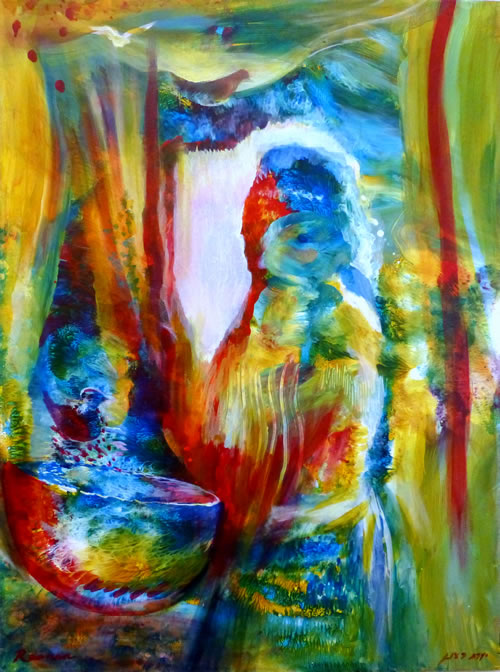Healing spiritual dis-ease involves both realignment with the source of creation and reconnection with community. Both require a measure of humility. View the study sheet here. Watch the recording here.

Kermes echinatus is a very small insect. The adult female grows to about 3 to 7 mm in length, about .11 to .27 inches. At maturity, the female attaches to an oak tree. There she sucks in the sap of the host tree. During the peak of her adulthood, which lasts about one month, she produces dye, a red dye.
In the December 2005 issue of BioScience, the official journal of the American Institute of Biological Sciences, four Israeli scientists identified Kermes echinatusas as a parasite of an oak indigenous to the land of Israel, Quercus calliprinos, and as the source of the red dye identified in the Bible as shani.
Translated variously as “crimson” or “scarlet,” shani appears several times in the Bible, in particular in connection with the creation of sacred space and with rites of purification: the creation and restoration of holy dimensions. Yarns of shani are among the materials to be used in constructing the Mishkan and the priestly garments (Exodus 25:4, 28:8 and 35:6). Shani material is part of the red heifer mixture used to ritually purify someone defiled by contact with a corpse (Numbers 19:6).
And it appears in this week’s Torah portion. It is included in the mixture which is sprinkled on a person or a dwelling that has become infected with a scaly surface condition called tzara’at. It is a condition causing the infected to be considered tamei, impure, and results in the person’s isolation or in the removal of the dwelling’s infected components.
Pictured here is Israeli artist Yoram Raanan’s painting Purification. It is inspired by Torah’s description of the priest mixing the ingredients for the compound that restores purity to one afflicted with tzara’at. The canvass is awash in a full spectrum of color. Wavy lines in the center convey a sense of movement, of transition. The features of the priest dissolve into anonymity.
Critical to the purification ritual is the inclusion of crimson (shani) material. Such a large and transformative role by such a small and short-lived creature.
Hasidic teaching identifies impurity with being distant from the Source of all life. For a human being this is expressed through a pathological assertion of self. Restoration to spiritual wholeness involves an ingredient of humility, an extinguishing of one’s inflated self.
Passover, the celebration of freedom, requires us to remove hametz, leavened bread, from our home. Hasidic wisdom applies this ritual of purification also to the home that is our being. We are to clean out arrogance from our ego.
The poet Yehuda Amichai in his piece “The Place Where We Are Right” writes: From the place where we are right/Flowers will never grow/The place where we are right/Is hard and trampled/Like a courtyard/But doubts and wondering/Dig up the world/Like a mole/Like a plow/And a whisper will be heard/In the place where the House once stood/That was destroyed.
The shabbat immediately before Passover is called Shabbat HaGadol. The Great Shabbat. The haftarah portion for Shabbat HaGadol is from the prophet Malachi. We do not know the identity of Malachi (“My Messenger”). It has dissolved into anonymity. He represents a turning point in Judaism. The end of prophecy. Up through Malachi God spoke to selected individuals and conveyed to them a message and a mission. After Malachi, humans, not God, would identify truth.
The parting words of this last prophet, read immediately before Passover, include these: “Behold, I send you Elijah the prophet, before the coming of the great and awe-filled days of God, to turn the hearts of parents to their children and the hearts of children to their parents.”
In dramatic enactment of this mutual turning, a child and an adult each bring toward one another a broken half of a matzo. With the most iconic symbol of Passover restored to its wholeness, the drama of the seder’s journey can now conclude in peace, and in the faith that is manifested as confident hope.
What makes this particular shabbat “Great”? It is the small and simple things, matters that are very much in our hands. A turning towards one another and a sharing of our unleavened souls. And where mighty structures of arrogance once stood “a whisper will be heard.”
Hatikvah. Shalom.
Join us here at 7:00 p.m. (PT) on Thursday April 18 as we explore a whisper will be heard.








